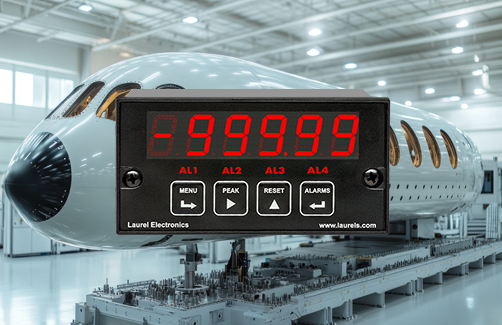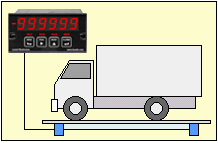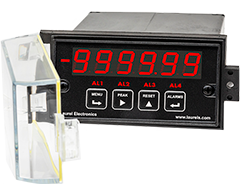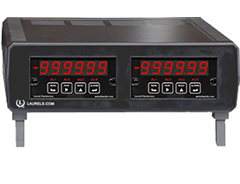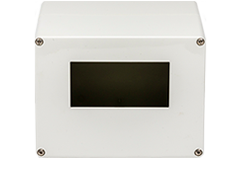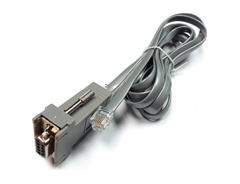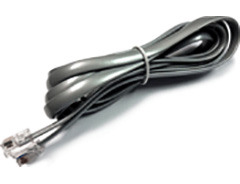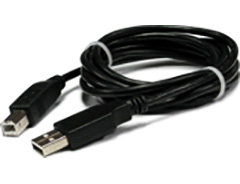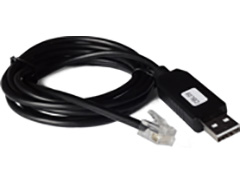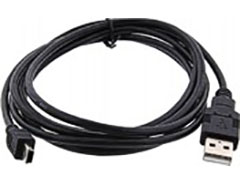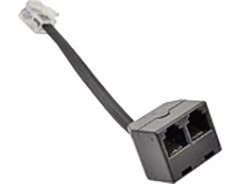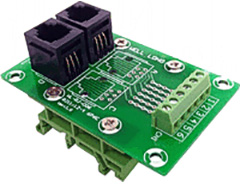- Description
- Specifications
- Setup Software
- Mechanical
- Documents
- Technical FAQ
- Applications
- Accessories
Features
- Digital panel meter optimized for weighing applications
- Accuracy of 0.01% of reading ± 2 counts
- Display toggle between gross or net weight
- 4- or 6-wire hookup to avoid lead resistance effects
- 10 Vdc excitation to power four 350-ohm load cells in parallel (isolated)
- Count by 1, 2, 5, 10, 20, 50 or 100 with rounding
- 5-digit resolution with scaling from 0 to 99,999
- Auto-tare or manual tare, with tare value stored in non-volatile memory
- All input ranges are user selectable and factory calibrated
- Up to 60 conversions per second, Ideal for peak or valley capture
- Digital span adjust from 0 to ±99,999, zero adjust from -99,999 to +99,999
- Front panel scalable to ±99,999 for use with current shunts
- 1/8 DIN size with bright red or green 0.56" (14.2mm), high LED digits
- Transducer excitation output, 5, 10, 12, or 24 Vdc (isolated)
- Power 85-264 Vac / 90-300 Vdc or 10-48 Vdc / 12-32 Vac (isolated)
- Operating temperature from -40°C to 85°C (-40°F to 158°F)
- Wide choice of Plug-in-Play options:
- 2 or 4 relays, mechanical or solid state, for alarm or control (isolated)
- 1 or 2 Analog output, 4-20 mA, 0-20 mA, 0-10V, or -10V to +10V (isolated)
- Communications: Ethernet, WiFi, USB, RS232, RS485 (isolated)
The Laureate™ 1/8 DIN Digital Panel Meter for scale weighing applications
is compact, inexpensive, and extremely accurate digital panel meter with special firmware for weighing applications. It is available with the Laureate load cell or DC signal conditioner board. If you do not need the special weighing firmware, consider using the Laureate load cell meter or Laureate process meter.The DC signal conditioner board can used in lieu of the load cell signal conditioner board, be set to ratiometric operation, and be used with the meter's 5 Vdc or 10 Vdc excitation. It's most sensitive full-scale range is ±200 mV with 10 µV resolution, while the load cell signal conditioner board offers most sensitive ranges of ±20 mV and ±50 mV, both with 1 µV resolution. Meters with both boards offer an accuracy of 0.01% of full scale ± 2 counts.
All signal conditioner board ranges are factory-calibrated, with calibration factors for each range securely stored in an onboard EEPROM. These factors can be scaled via software to accommodate external shunts, enabling field replacement of signal conditioner boards without necessitating recalibration of the associated digital panel meter. For optimal accuracy, factory recalibration is recommended annually. All Laurel Electronics instruments undergo factory calibration using the industry-leading Fluke calibrators, which are recalibrated yearly and certified traceable to national standards, ensuring the highest level of precision and reliability.
Scaling is from -99,999 to +99,999 (five full digits) with any decimal point to display readings in engineering units, such as PSI. Three scaling methods are user selectable: scale and offset, two-point method, and system-level calibration using actual transducer signals.
Meter accuracy in ratiometric bridge operation is 0.01% of reading ± 2 counts. Custom curve linearization, which is available with the optional Extended main board, can extend the working range of load cells. Custom curve linearization also allows greater accuracy to be achieved with lower cost, less linear load cells.
A built-in isolated excitation supply can provide up to 120 mA of current at 10V to power four 350-ohm load cells in parallel. The meter operates in a ratiometric mode to eliminate errors due to supply variations. When excitation sense inputs are used in 6-wire connection, the meter compensates for variation in resistance of the transducer leads, thereby allowing long cable runs.
Display & Setpoint Functions for Weighing Applications
- Relay setpoint offset. The ON/OFF setpoint control action can be programmed to occur with a specified offset. For instance, if bags are to be filled to 100 lbs and the material delivery spout is known to hold and dispense an additional 2.5 lbs following shut-off, an offset of -2.5 lbs can be programmed. The setpoint can then be set to 100 lbs, and the filling valve will be automatically shut off when the measured weight reaches 97.5 lbs.
- Count-by function. The weight meter can be programmed so that the display is rounded off to multiples of 1, 2, 5, 10, 20, 50 or 100. For example, if count-by 10 is selected, the meter will display 20 for an internal count of 15 to 24.
- Fixed right-hand dummy zero. The display can be shifted to the left for a fixed zero to the right, allowing values up to 999,990 to be displayed. The right-hand zero precludes the use of decimal points.
- Auto-zero function. An auto-zero limit from 0 to 9 counts can be programmed to compensate for load cell drift. Whenever the meter comes to rest within that limit from zero, it will auto-zero. Entering 0 disables auto-zero.
- Two tare functions: auto-tare and manual tare. In auto-tare, an input line is grounded by an external pushbutton. This causes the current weight, which is normally the empty weight of the container to be stored in memory as an offset. In manual tare, the tare value can be entered manually via the front panel or a computer using Laurel's free Instrument Setup Software. For instance, the tare value may be the stated empty weight of a truck or rail car. Pressing the Reset button on the front panel toggles the display between gross weight (total weight on the scale) and net weight (gross weight with tare subtracted).
Laureate Digital Panel Meters are easily programmed with Laurel’s free Instrument Setup Software, downloadable from our website and compatible with Windows PCs, requiring a data interface board for setup.
Easy scale calibration is achieved using a simple two-point calibration method. First, the desired LO IN reading is set to 0, and the desired HI IN reading is set to a desired value. With no weight on the scale, a button is pushed for LO IN. With a known weight on the scale, that button is pushed again for HI IN. The meter then automatically computes scale and offset for readout up to five digits in weight units.
High read rate of up to 50 or 60 conversions per second, the Laureate™ Digital Panel Meter uses Concurrent Slope (US Pat. 5,262,780) analog-to-digital conversion to integrate signals over a full power line cycle (50 Hz or 60 Hz). This read rate enables peak and valley capture, real-time computer interfacing, and control applications. Peak and valley values are automatically captured and can be viewed using Laurel’s free Instrument Setup Software (compatible with Windows PCs) or transmitted as serial data.
- An unfiltered selection provides true peak and valley readings and aids in control applications.
- A batch average filter selection averages each 16 conversions.
- An adaptive moving average filter selection provides a choice of 8 time constants from 80 ms to 9.6 seconds. When a significant change in signal level occurs, the filter adapts by briefly switching to the shortest time to follow the change, then reverts back to its selected time constant. An Auto setting selects the time constant selection based on signal noise.
Scale and offset can be provided by either of two user-selectable methods:
- With the coordinate reading method, the meter reads the high and low signal values, and the user enters the desired high an low reading values. The meter then calculates the span multiplier and offset. This method is ideal if an external calibration reference is available.
- With the manual coordinate method, the user enters the high and low input values in Volts plus the desired high and low reading values. This method is suitable if no external calibration reference is available.
Peak and valley values are automatically captured. These may be displayed via a front panel pushbutton command or control signal at the rear connector, or be transmitted as serial data.
Two rear panel control Inputs (CMOS/TTL levels, logic 0 = tied to digital ground, logic 1 = open) or dry contacts that can be set to control / activate 14 meter commands.
An (isolated) 5, 10, 12, or 24 Vdc excitation output is standard to power transducers or two-wire transmitters. Ratiometric operation, which automatically compensates for changes in the applied excitation, is jumper selectable for applications, such as bridges, where the signal to be measured is proportional to the excitation level.
Modular Design for Maximum Flexibility at Minimum Cost
All boards are isolated from meter and power grounds. Optional Plug-in-Play boards for communications and control include Ethernet, WiFi, serial communication boards, dual or quad relay boards, and an analog output board. Laureates may be powered from 85-264 Vac or optionally from 12-32 Vac or 10-48 Vdc. The display is available with bright red or green 0.56" (14.2mm) high LED digits. The 1/8 DIN case meets NEMA 4X (IP65) specifications from the front when panel mounted. Any setup functions and front panel keys can be locked out for simplified usage and security. A built-in 5, 10, 12, or 24 Vdc excitation supply can power transducers, eliminating the need for an external power supply. All power and signal connections are via UL / VDE / CSA rated screw clamp plugs.
The Laureate™ Series features modular design with up to 7 isolated plug-in boards, applicable to all Laureate 1/8 DIN Digital Panel Meters.

Modular Hardware
The design of the Laureate™ Series is modular for maximum flexibility at minimum cost. All boards are isolated from meter and power grounds. The base configuration for a panel meter or counter consists of a main module (with computer and plug-in display boards), a power supply board, and a signal conditioner board. Optional plug-in-play boards include an isolated setpoint controller board, an isolated analog output board, and an isolated digital interface board. Modular design and a choice of plug-in options allow the Laureate to be customized for a broad range of applications from simple monitoring to control and computer interface. There can be up to five plug-in boards in a 1/8 DIN Laureate.

Connecting Laureate Digital Panel Meters to a Local Area Network (LAN)
Up to 30 Laureate Digital Panel Meters and/or LT Transmitters can be configured for RS485 and daisy-chained to an LT Transmitter using Laurel’s High Speed Ethernet-to-RS485 converter board for seamless LAN integration. Alternatively, Laurel LTE series Ethernet transmitters can connect directly to a LAN via an Ethernet cable. Setup for both configurations is streamlined using Laurel’s free Instrument Setup Software, which simplifies node discovery and transmitter configuration.
Flexible Communication Options for Digital Panel Meters
Laureate Digital Panel Meters can be equipped with Laurel communication boards to support various interfaces and protocols. These include serial interfaces with ASCII or Modbus RTU protocols, and Ethernet interfaces with web access, ASCII, or Modbus TCP/IP protocols, ensuring versatile connectivity for your commercial applications.

DC Signal Conditioner
| Full-Scale Input | Input Impedance | Zero Adjust | Span Adjust | Error at 25°C |
|---|---|---|---|---|
| ± 200.00 mV | 1 GΩ | |||
| ± 2.0000 V | 1 GΩ | -99,999 | 0 to | 0.01% FS |
| ± 20.000 V | 10 MΩ | to +99,999 | ±99,999 | ± 2 counts |
| ± 20.000 mA | 10 Ω | |||
| Recalibration: All ranges are calibrated at the factory. Recalibration is recommended every 12 months. | ||||
| Display | |
|---|---|
| Readout | 5 LED digits, 7-segment, 14.2 mm (.56"), red or green |
| Range | -99999 to +99999 |
| -999990 to +999990 (with fixed selectable right-hand zero) | |
| Rounding | Count by 1, 2, 5, 10, 20, 50, 100 |
| Indicators | Four LED lamps |
| Accuracy | |
| Error at 25°C | 0.01% FS ± 2 counts |
| Span tempco | 0.0015% of reading/°C |
| Zero tempco | 0.1 µV/°C (use auto-zero when temperature changes) |
| Calibration Method | 2 points using zero weight and known weight |
| Noise Rejection | |
| CMR, DC to 60 Hz | 130 dB |
| NMR at 50/60 Hz | 90 dB with min filtering |
| A-to-D Conversion | |
| Technique | Concurrent Slope (Pat 5,262,780) |
| A-to-D rate | 60/s at 60 Hz, 50/s at 50 Hz |
| Output update | 56/s at 60 Hz, 47/s at 50 Hz |
| Display update | 3.5/s at 60 Hz, 3/s at 50 Hz |
| Power Supply Boards (one required) | |
| Voltage, standard | 85-264 Vac or 90-300 Vdc |
| Voltage, optional | 12-32 Vac or 10-48 Vdc |
| Frequency | DC or 47-63 Hz |
| Power consumption (typ. with four 350Ω load cells at 10V) | 2.4W @ 120 Vac, 2.7W @ 240 Vac, 2.5W @ 10 Vdc, 2.6W @ 20 Vdc, 2.75W @ 30 Vdc, 3.0W @ 40 Vdc, 3.35W @ 48 Vdc |
| Power Isolation | 250V rms working, 2.3 kV rms per 1 min test |
| Excitation Output (standard) | |
| 5 Vdc | 5 Vdc ± 5%, 100 mA (jumper selectable) |
| 10 Vdc | 10 Vdc ± 5%, 120 mA (jumper selectable) |
| 12 Vdc | 12 Vdc ± 5%, 100 mA (jumper selectable) |
| 24 Vdc | 24 Vdc ± 5%, 50 mA (jumper selectable) |
| Output Isolation | 50 Vdc from signal ground |
| Ratiometric operation | Automatically compensates for changes in excitation level. |
| Analog Output Board (one optional) | |
| Output levels | 4-20 mA, 0-20 mA, 0-10V |
| Current compliance | 2 mA at 10V ( > 5 kΩ load) |
| Voltage compliance | 12V at 20 mA (< 600 Ω load) |
| Scaling | Zero and full scale adjustable from -99999 to +99999 |
| Resolution | 16 bits (0.0015% of full scale) |
| Isolation | 250V rms working, 2.3 kV rms per 1 min test |
| Relay Output Boards (one optional) | |
| Dual magnetic relays | 2 Form C, 8A max, 440Vac or 125Vdc max, 2500VA or 300W |
| Quad magnetic relays | 4 Form A (NO), 8A max, 440Vac or 125Vdc max, 2500VA or 300W |
| Dual solid state relays | 2 Form A (NO), AC or DC, 0V - 400V, 120Ma, 35Ohms (max at On-State) |
| Quad solid state relays | 4 Form A (NO), AC or DC, 0V - 400V, 120Ma, 35Ohms (max at On-State) |
| Relay commons | Isolated commons for dual relays or each pair of quad relays |
| Relay isolation | 250V rms working, 2.3 kV rms per 1 minute test |
| Relay latching modes | Latching or non-latching |
| Relay active modes | Active on or off, active high or low |
| Hysteresis modes | QA passband mode, split hysteresis, span hysteresis |
| Communication Boards (one optional) | |
| Board selections | RS232, RS485 with dual RJ11 connectors, RS485 with dual RJ45 connectors, USB, USB-to-RS485 gateway, WiFi with built-in antenna plus USB & RS485, WiFi with external antenna plus USB & RS485 |
| Protocols | Modbus RTU, Modbus ASCII, Modbus TCP (Ethernet), Laurel ASCII |
| Digital addresses | 247 (Modbus), 31 (Laurel ASCII), |
| Isolation | 250V rms working, 2.3 kV rms per 1 min test |
| Environmental | |
| Operating temperature | -40°C to 70°C (-40°F to 158°F) |
| Storage temperature. | -40°C to 85°C (-40°F to 185°F) |
| Relative humidity | 95% at 40°C, non-condensing |
| Protection | NEMA-4X (IP-65) when panel mounted |
| Mechanical | |
| Enclosure | 1/8 DIN, high impact plastic, UL 94V-0, color: black |
| Mounting | 1/8 DIN panel cutout required: 3.622" x 1.772" (92 mm x 45 mm). |
| Dimensions | 4.68" x 2.45" x 5.64" (119 mm x 62 mm x 143 mm) (W x H x D) |
| Maximum panel thickness | 4.5 mm (0.18") |
| Tightening Torque - Connectors | Screw terminal connectors: 5 lb-in (0.56 Nm) |
| Tightening Torque - Pawls | Digital Panel Meter Case Pawls: 5 lb-in (0.56 Nm) |
| Weight of base meter | 210 g (7.4 oz) typical (DPM, counter, timer, 6-digit remote display) |
| Weight of option boards | 30 g (1.0 oz) typical per board (analog output, relay output, communications) |
| General | |
| Programming Methods | Four front panel buttons or via Laurel's free Instrument Setup Software, which runs on a PC under MS Windows. |
| Security | Lockout options include using the front panel buttons, the free Instrument Setup Software, or a hardware jumper. |
| Warranty | 3 years parts & labor |
| Recalibration: All ranges are calibrated at the factory. Recalibration is recommended every 12 months. | |
Free Instrument Setup Software for Series 2 Laureates
Free Downloadable Windows-based Instrument Setup (IS) software (Data Interface Board Required) for use with our programmable Digital Panel Meters, Scale Meters, Counters, Timers, Remote Displays, and Transmitters, are an easy method to set up Laureate 1/8 DIN digital panel meters, counters, timers, remote displays, and DIN-rail transmitters, as explained in the Instrument Setup Software Manual. Laureate 1/8 DIN instruments can also be set up from the front panel, as explained in their respective Owners Manuals. Instrument Setup software is of benefit whether or not the PC is connected to the instrument.
- When the PC is connected to the instrument, Instrument Setup software can retrieve the setup file from the instrument or open a default setup file or previously saved setup file from disk View Setup, then provides graphical user interface (GUI) screens with pull-down menus applicable to input, display, scaling, filtering, alarms, communications, analog output, and front panel lockouts. Fields that are not applicable to the instrument as configured are either left out or grayed out. Clicking on any item will bring up a detailed Help screen for that item. After editing, the setup file can be downloaded, uploaded to the instrument, or saved to a disk. The same setup file can then be downloaded into multiple instruments.
- When the PC is not connected to the instrument, the above GUI screens can be used to set up a virtual instrument. The setup file can then be saved to disk. Switching toView Menu then brings up a screen with the required front panel programming steps. This view can be printed out for use at the instrument site and to serve as a hard copy record.
Download Free Instrument Setup Software
Installation
Set User Account Control (UAC) of MS Windows to "Never notifiy me" so that Instrument Setup Software can create directories. The UAC change screen can be reached as follows:
- Under Windows 7, click on the Windows Start button in the lower left of the desktop and enter "UAC" in the search field.
- Under Windows 8, navigate to Control Panel, then to the "User Accounts and Family Safety" section, and click on "Change User Account Control Settings."
- Under Windows 10, click on the Windows Start button in the lower left of the desktop, then on "Settings", and enter "UAC" in the search field.
- Reboot your computer for the changed UAC setting to take effect.

RJ11-to-DB9 cable with rear view of DB9 connector to PC

RS232 cable, meter to PC, P/N CBL01
Laureate 1/8 DIN Laureate instruments must be equipped with a serial communications board and be connected to the computer via a serial communications cable. The connection can be via RS232, RS485, USB or Ethernet. Following setup, the serial communications board may be removed from the instrument if desired. The wiring of the RS232 cable is illustrated above with end views of the two connectors.
Laureate LT Series transmitters come standard with a 3-wire serial interface, which can be jumpered for RS232 or RS485.
Laureate LTE Series transmitters come standard with an Ethernet interface.
Meter Setup Screens
Click on any of the reduced screens below for a full-size screen view, then click on the Back button of your browser to return to this page. The screens examples below are for a fully-loaded Series 2 Digital Panel Meter (DPM), which is connected to the PC via RS232. If the meter is a Series 1 meter (pre-2007), this is sensed by the software, and somewhat different screens are brought up. Please see Series 1 setup screens.











Meter Setup Utilities




From the Main Menu, click on Readings if your PC is connected to the meter. A pull-down menu then offers three choices: List, Plot and Graph.
- List presents the latest readings in a 20-row by 10-column table. Press Pause at any time to freeze the display. This is one method to capture peak readings.
- Plot generates a plot of readings vs. time in seconds. It effectively turns the DPM-PC combination into a printing digital oscilloscope.

- Graph generates a histogram where the horizontal axis is the reading and the vertical axis is the number of occurrences of readings. The display continually resizes itself as the number of readings increases.



Laureate™ 1/8 DIN Case For Laureate Digital Panel Meters, Counters, Timers & Remote Displays
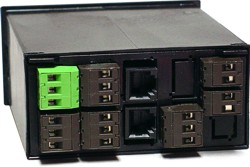
Key Features
- Meets 1/8 DIN Standard.
- Installs from front of panel.
- Short depth behind the panel: only 4" (102 mm) plus connectors.
- Understated 0.157" (4 mm) thick bezel.
- Meets NEMA 4X (IP-65) for high-pressure wawshdon when panel mounted.
- Screw clamps connectors meet VDE / IEC / UL / CSA safety standards.
- Rugged GE Lexan® housing material.
- Safety certified per EN 61010-1.
Dimensions
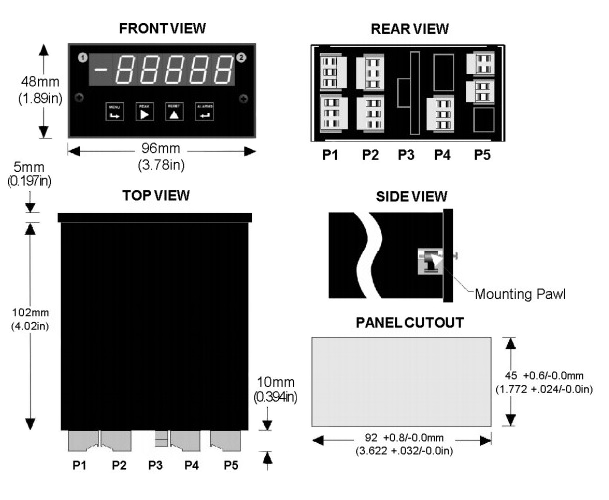
Maximum panel thickness: 4.5 mm (0.18")
Weight of base meter: 210 g (7.4 oz) typical (DPM, counter, timer, 6-digit remote display)
Weight of option boards: 30 g (1.0 oz) typical per board (analog output, relay output, communications)
Tightening Torque - Connectors: Screw terminal connectors: 5 lb-in (0.56 Nm)
Tightening Torque - Pawls: Digital Panel Meter Case Pawls: 5 lb-in (0.56 Nm)
Dimensioned CAD assembly drawings in EPRT, STEP, x_t. dwg, pdf file formats: Laureate-meter-case.zip (zipping prevents browser from opening CAD files as text files).
Panel Mounting
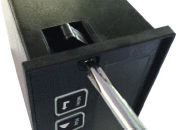 Slide the meter into a 45 x 92 mm 1/8 DIN panel cutout. Ensure that the provided gasket is in place between the front of the panel and the back of the meter bezel.
The meter is secured by two pawls, each held by a screw, as illustrated. Turning each screw counterclockwise extends the pawl outward from the case and behind the panel. Turning each screw clockwise further tightens it against the panel to secure the meter.
Slide the meter into a 45 x 92 mm 1/8 DIN panel cutout. Ensure that the provided gasket is in place between the front of the panel and the back of the meter bezel.
The meter is secured by two pawls, each held by a screw, as illustrated. Turning each screw counterclockwise extends the pawl outward from the case and behind the panel. Turning each screw clockwise further tightens it against the panel to secure the meter.
Turning each screw counterclockwise loosens the pawl and retracts it into its well. This position allows installed meter to be removed from their panel, or new meters to be installed in a panel. Do not remove the screws from their pawls. Doing so would cause the screw and pawl to fall off and likely get lost. Do not overtighten so as not to damage the plastic parts.
Scale Meter Frequently Asked Technical Questions
Application Example: Weighing the Load on a Truck
The Laureate weight meter power all four 350 ohm load cells of the scale with its 10 V, 120 mA isolated excitation output. Six-wire connection eliminates the effects of lead resistance and allows long cable runs from the control room to the scale.
The five-digit meter can be scaled to display truck weight up to 99,999 lbs with 1 lb resolution or 999,990 lbs with 10 lb resolution. Accuracy is 0.01% of full scale at 25°C. To avoid the effects of system-level noise, different filter settings as well as "count by" of 1, 2, 5, 10, 20, 50 or 100 with rounding are selectable.
To read out net weight of the load, the truck can first be weighed empty, and this weight can be entered as tare at the push of a button in an auto-tare mode. Or the nominal tare value of the truck can be entered manually. Display of net weight or gross weight is at the push of a button. The gross weight and net weight can be alarmed, be transmitted to a computer via RS232 or RS485, or be transmitted via a 4-20 mA analog signal.
IPC
Splashproof Cover
CLB01
RS232 Cable for Meters
CLB02
USB-to-RS232 Adapter Cable
CBL04
RS232 Cable for LT Transmitters
CLB05
USB Data Cable for Meters
CLB06
USB-to-RS485 Adapter Cable
CLB07
USB Programming & Data Cable
CLB08
RS485 Splitter Cable
BKBD
RS485 RJ11 Terminal Block Adapter
What is a Digital Panel Meter for Scale and Weighing Applications?
A digital panel meter is a precision instrument designed to measure, display, and monitor electrical signals from sensors used in scale and weighing applications, such as load cells. These devices are essential in industries requiring accurate weight measurements, including manufacturing, logistics, agriculture, and food processing. By converting analog signals into clear digital readouts, digital panel meters ensure reliable data for process control, quality assurance, and compliance with industry standards.
Unlike analog meters, digital panel meters offer superior readability, programmable features, and integration with modern systems. They are critical for applications where precise weight data drives operational efficiency, inventory management, or regulatory adherence.
Understanding the Digital Panel Meter for Weighing
Digital panel meters for scale and weighing applications are often built to the 1/8 DIN standard, fitting compactly into panel cutouts (approximately 92 mm x 45 mm). This size ensures compatibility with control panels while maximizing space efficiency. These meters are designed for durability, ease of use, and high accuracy, making them ideal for demanding environments like factories, warehouses, or processing plants.
These meters support inputs from load cells, which convert weight or force into electrical signals. They feature customizable displays, calibration options, and communication interfaces (e.g., RS-485, Modbus) to integrate with industrial systems. Their versatility allows them to handle various weighing tasks, from simple bench scales to complex multi-load-cell systems.
How Does a Digital Panel Meter Work in Weighing Applications?
A digital panel meter processes analog signals from load cells to provide accurate weight measurements. Here’s a detailed overview of its operation:
- Signal Acquisition:
The meter receives an analog signal from a load cell, which generates a voltage proportional to the applied weight or force. These signals are typically low-level, requiring sensitive input circuitry. - Signal Conditioning:
The signal is amplified, filtered, or adjusted to eliminate noise and ensure it matches the meter’s operational range. This step is crucial for maintaining accuracy in noisy industrial environments. - Analog-to-Digital Conversion:
An Analog-to-Digital Converter (ADC) transforms the conditioned signal into a digital format. High-resolution ADCs ensure precise weight measurements, even for small load changes. - Processing and Display:
The digital signal is processed by the meter’s microcontroller, which applies calibration, scaling, or unit conversions (e.g., kg, lb, oz). The result is shown on a clear LED or LCD display. - Output and Integration:
The meter may provide outputs like 4-20 mA analog signals, relay contacts for alarms, or digital communication (e.g., Ethernet, USB) for integration with PLCs, SCADA systems, or data loggers. - Calibration and Configuration:
Users can calibrate the meter to match specific load cells and configure settings like tare functions, measurement units, or alarm thresholds to suit application needs.
Key Features of Digital Panel Meters for Weighing
Digital panel meters for scale and weighing applications include features that enhance performance and usability:
- High Precision: Advanced ADCs deliver accurate weight measurements, critical for applications like batching or quality control.
- Tare and Zero Functions: Programmable tare allows users to subtract container weights, while zeroing resets the scale for consistent readings.
- Flexible Displays: Multi-color LEDs, bar graphs, or large-digit displays ensure readability in various lighting conditions.
- Programmable Alarms: Setpoints for over/under weight conditions trigger alerts or control external devices like conveyors.
- Communication Options: Protocols like Modbus or Profibus enable integration with industrial automation systems.
- Rugged Design: IP65-rated front panels resist dust and moisture, ideal for harsh environments like food processing plants.
Applications of Digital Panel Meters in Scale and Weighing Systems
Digital panel meters are widely used in weighing applications across industries. Key applications include:
- Industrial Weighing:
Digital panel meters display weight data from load cells in platform scales, tank weighing systems, or conveyor belts, supporting tasks like inventory management or production monitoring. - Batch Weighing:
In manufacturing, DPMs ensure precise ingredient measurements for processes like chemical mixing or food production, maintaining product consistency and reducing waste. - Logistics and Shipping:
Weighing systems in warehouses or distribution centers use digital panel meters to verify package weights, ensuring compliance with shipping regulations and accurate billing. - Agricultural Weighing:
In farming, DPMs monitor grain, feed, or livestock weights, supporting efficient resource management and regulatory compliance. - Retail and Commercial Scales:
Digital panel meters are used in retail scales for markets or supermarkets, providing accurate measurements for pricing and inventory.
Where Are Digital Panel Meters for Scale and Weighing Applications Used?
Digital panel meters (DPMs) are critical in industries where precise weight measurements are essential. When paired with load cells in scale and weighing systems, 1/8 DIN digital panel meters provide compact, reliable solutions. Below are detailed use cases across key sectors:
- Manufacturing and Production:
In factories, digital panel meters monitor weights in assembly lines or batching systems. For example, in pharmaceutical production, DPMs ensure precise measurements of active ingredients, meeting strict regulatory standards. - Food and Beverage Processing:
Load cells in filling machines or checkweighers rely on digital panel meters to ensure consistent product weights. In a bottling plant, DPMs verify fill levels to prevent under- or over-filling, maintaining quality and cost efficiency. - Logistics and Warehousing:
Digital panel meters in pallet scales or forklift weighing systems provide real-time weight data, streamlining inventory tracking and ensuring compliance with weight regulations for shipping. - Agriculture and Farming:
In grain silos or livestock weighing systems, DPMs display accurate weights, helping farmers optimize feed distribution, monitor crop yields, or comply with trade standards. - Recycling and Waste Management:
Weighing systems in recycling plants use digital panel meters to measure scrap or waste materials, supporting efficient sorting and billing processes. - Construction and Materials Handling:
In concrete batching plants or aggregate weighing systems, DPMs ensure precise material measurements, improving the quality of construction materials and reducing waste. - Retail and Commercial Weighing:
In markets or delis, digital panel meters provide accurate weight readouts for pricing goods, enhancing customer trust and operational efficiency.
Benefits of Using Digital Panel Meters in Weighing Applications
Digital panel meters offer numerous advantages for scale and weighing systems:
- Accuracy and Reliability: High-resolution ADCs ensure precise weight measurements, critical for quality control and compliance.
- Compact Design: The 1/8 DIN size fits easily into control panels, ideal for space-limited setups.
- Customizability: Programmable settings like tare, units, or alarms adapt to specific weighing needs.
- System Integration: Communication interfaces enable seamless connection to automation systems, enhancing data logging and process control.
- Durability: Built to withstand dust, moisture, and temperature fluctuations, DPMs perform reliably in industrial environments.
- User-Friendly Operation: Intuitive controls and clear displays simplify setup and use, reducing training time.
Choosing the Right Digital Panel Meter for Weighing
When selecting a digital panel meter for scale and weighing applications, consider these factors:
- Load Cell Compatibility: Ensure the meter supports the load cell’s input range and excitation voltage.
- Accuracy Specifications: Verify the meter’s resolution and accuracy meet your application’s requirements.
- Environmental Durability: Choose a meter with appropriate IP ratings for dust, water, or temperature resistance.
- Output Requirements: Determine if you need analog outputs, relays, or digital communication for integration with other systems.
- Display and Usability: Opt for a display that’s easy to read and controls that suit your operators’ needs.
- Calibration Features: Look for easy-to-use calibration and tare functions to streamline setup and maintenance.
Conclusion
Digital panel meters, particularly 1/8 DIN models, are essential for scale and weighing applications across industries like manufacturing, logistics, agriculture, and food processing. Their precision, compact design, and versatile features make them ideal for delivering accurate weight measurements in demanding environments. By supporting efficient processes, regulatory compliance, and system integration, digital panel meters enhance productivity and reliability in weighing systems. Whether for industrial scales or retail applications, these meters provide a robust solution for modern weighing needs.
Less Information.








